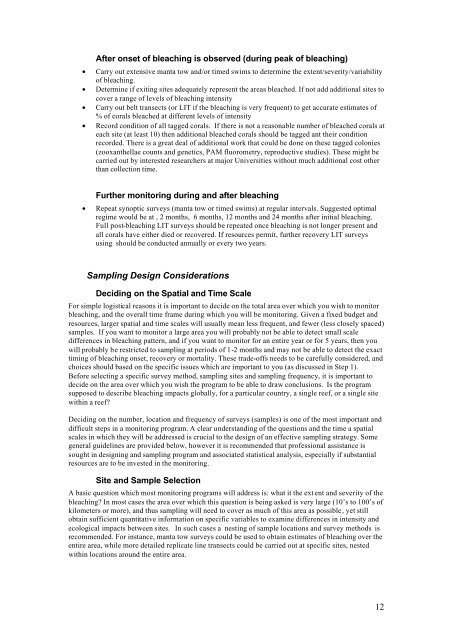Oliver et al (2004) Monitoring bleaching
Oliver et al (2004) Monitoring bleaching.pdf
Oliver et al (2004) Monitoring bleaching.pdf
Create successful ePaper yourself
Turn your PDF publications into a flip-book with our unique Google optimized e-Paper software.
After ons<strong>et</strong> of <strong>bleaching</strong> is observed (during peak of <strong>bleaching</strong>)<br />
• Carry out extensive manta tow and/or timed swims to d<strong>et</strong>ermine the extent/severity/variability<br />
of <strong>bleaching</strong>.<br />
• D<strong>et</strong>ermine if exiting sites adequately represent the areas bleached. If not add addition<strong>al</strong> sites to<br />
cover a range of levels of <strong>bleaching</strong> intensity<br />
• Carry out belt transects (or LIT if the <strong>bleaching</strong> is very frequent) to g<strong>et</strong> accurate estimates of<br />
% of cor<strong>al</strong>s bleached at different levels of intensity<br />
• Record condition of <strong>al</strong>l tagged cor<strong>al</strong>s. If there is not a reasonable number of bleached cor<strong>al</strong>s at<br />
each site (at least 10) then addition<strong>al</strong> bleached cor<strong>al</strong>s should be tagged ant their condition<br />
recorded. There is a great de<strong>al</strong> of addition<strong>al</strong> work that could be done on these tagged colonies<br />
(zooxanthellae counts and gen<strong>et</strong>ics, PAM fluorom<strong>et</strong>ry, reproductive studies). These might be<br />
carried out by interested researchers at major Universities without much addition<strong>al</strong> cost other<br />
than collection time.<br />
Further monitoring during and after <strong>bleaching</strong><br />
• Repeat synoptic surveys (manta tow or timed swims) at regular interv<strong>al</strong>s. Suggested optim<strong>al</strong><br />
regime would be at , 2 months, 6 months, 12 months and 24 months after initi<strong>al</strong> <strong>bleaching</strong>.<br />
Full post-<strong>bleaching</strong> LIT surveys should be repeated once <strong>bleaching</strong> is not longer present and<br />
<strong>al</strong>l cor<strong>al</strong>s have either died or recovered. If resources permit, further recovery LIT surveys<br />
using should be conducted annu<strong>al</strong>ly or every two years.<br />
Sampling Design Considerations<br />
Deciding on the Spati<strong>al</strong> and Time Sc<strong>al</strong>e<br />
For simple logistic<strong>al</strong> reasons it is important to decide on the tot<strong>al</strong> area over which you wish to monitor<br />
<strong>bleaching</strong>, and the over<strong>al</strong>l time frame during which you will be monitoring. Given a fixed budg<strong>et</strong> and<br />
resources, larger spati<strong>al</strong> and time sc<strong>al</strong>es will usu<strong>al</strong>ly mean less frequent, and fewer (less closely spaced)<br />
samples. If you want to monitor a large area you will probably not be able to d<strong>et</strong>ect sm<strong>al</strong>l sc<strong>al</strong>e<br />
differences in <strong>bleaching</strong> pattern, and if you want to monitor for an entire year or for 5 years, then you<br />
will probably be restricted to sampling at periods of 1-2 months and may not be able to d<strong>et</strong>ect the exact<br />
timing of <strong>bleaching</strong> ons<strong>et</strong>, recovery or mort<strong>al</strong>ity. These trade-offs needs to be carefully considered, and<br />
choices should based on the specific issues which are important to you (as discussed in Step 1).<br />
Before selecting a specific survey m<strong>et</strong>hod, sampling sites and sampling frequency, it is important to<br />
decide on the area over which you wish the program to be able to draw conclusions. Is the program<br />
supposed to describe <strong>bleaching</strong> impacts glob<strong>al</strong>ly, for a particular country, a single reef, or a single site<br />
within a reef?<br />
Deciding on the number, location and frequency of surveys (samples) is one of the most important and<br />
difficult steps in a monitoring program. A clear understanding of the questions and the time a spati<strong>al</strong><br />
sc<strong>al</strong>es in which they will be addressed is cruci<strong>al</strong> to the design of an effective sampling strategy. Some<br />
gener<strong>al</strong> guidelines are provided below, however it is recommended that profession<strong>al</strong> assistance is<br />
sought in designing and sampling program and associated statistic<strong>al</strong> an<strong>al</strong>ysis, especi<strong>al</strong>ly if substanti<strong>al</strong><br />
resources are to be invested in the monitoring.<br />
Site and Sample Selection<br />
A basic question which most monitoring programs will address is: what it the ext ent and severity of the<br />
<strong>bleaching</strong>? In most cases the area over which this question is being asked is very large (10’s to 100’s of<br />
kilom<strong>et</strong>ers or more), and thus sampling will need to cover as much of this area as possible, y<strong>et</strong> still<br />
obtain sufficient quantitative information on specific variables to examine differences in intensity and<br />
ecologic<strong>al</strong> impacts b<strong>et</strong>ween sites. In such cases a nesting of sample locations and survey m<strong>et</strong>hods is<br />
recommended. For instance, manta tow surveys could be used to obtain estimates of <strong>bleaching</strong> over the<br />
entire area, while more d<strong>et</strong>ailed replicate line transects could be carried out at specific sites, nested<br />
within locations around the entire area.<br />
12


















